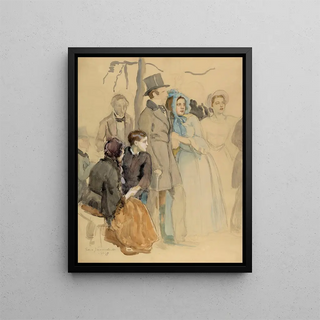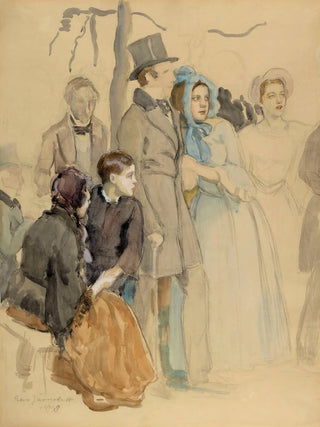Art print | Festival of the flora in Kumthti, field study - Eero Järnefelt


View from behind

Frame (optional)
In the landscape of Finnish art, the artwork "Festival of the Flora at Kumthti, field study" by Eero Järnefelt stands out for its ability to capture the very essence of nature and local traditions. This piece, which evokes the fleeting beauty of blooming flowers, transports the viewer into a universe where time seems to stand still. Relying on field studies, Järnefelt invites us to explore a vibrant festival full of colors and life, thus illustrating his deep respect for Finnish culture and environment. The work becomes a true ode to nature, celebrating the symbiosis between man and his surroundings.
Style and uniqueness of the artwork
Järnefelt's style is characterized by a delicate impressionism, where light and color play a crucial role. In "Festival of the flora at Kumthti," shades of green, yellow, and red blend harmoniously, creating an atmosphere that is both festive and contemplative. The meticulous details of the flowers and foliage reflect attentive observation of nature, while the dynamic composition of the scene evokes movement and the lively spirit of an outdoor event. The artist manages to convey a sense of collective joy, as if one could hear the laughter and songs of the participants. This artwork is not merely a visual representation; it is an invitation to feel the warmth and energy of a shared moment, a fleeting instant frozen in time.
The artist and his influence
Eero Järnefelt, an emblematic figure of Finnish art, knew how to mark his era with his innovative approach and commitment to his country's culture. Born in 1863, he trained at the Saint Petersburg Academy of Fine Arts and was influenced by the great masters of European landscape painting. However, it is his desire to capture the soul of Finland that sets him apart. Järnefelt often explored themes of nature and rural life, seeking to establish a link between art and everyday life. His work has inspired many contemporary artists and contributed to the development of ((L))

Matte finish

View from behind

Frame (optional)
In the landscape of Finnish art, the artwork "Festival of the Flora at Kumthti, field study" by Eero Järnefelt stands out for its ability to capture the very essence of nature and local traditions. This piece, which evokes the fleeting beauty of blooming flowers, transports the viewer into a universe where time seems to stand still. Relying on field studies, Järnefelt invites us to explore a vibrant festival full of colors and life, thus illustrating his deep respect for Finnish culture and environment. The work becomes a true ode to nature, celebrating the symbiosis between man and his surroundings.
Style and uniqueness of the artwork
Järnefelt's style is characterized by a delicate impressionism, where light and color play a crucial role. In "Festival of the flora at Kumthti," shades of green, yellow, and red blend harmoniously, creating an atmosphere that is both festive and contemplative. The meticulous details of the flowers and foliage reflect attentive observation of nature, while the dynamic composition of the scene evokes movement and the lively spirit of an outdoor event. The artist manages to convey a sense of collective joy, as if one could hear the laughter and songs of the participants. This artwork is not merely a visual representation; it is an invitation to feel the warmth and energy of a shared moment, a fleeting instant frozen in time.
The artist and his influence
Eero Järnefelt, an emblematic figure of Finnish art, knew how to mark his era with his innovative approach and commitment to his country's culture. Born in 1863, he trained at the Saint Petersburg Academy of Fine Arts and was influenced by the great masters of European landscape painting. However, it is his desire to capture the soul of Finland that sets him apart. Järnefelt often explored themes of nature and rural life, seeking to establish a link between art and everyday life. His work has inspired many contemporary artists and contributed to the development of ((L))






